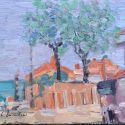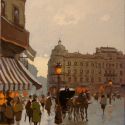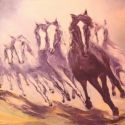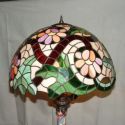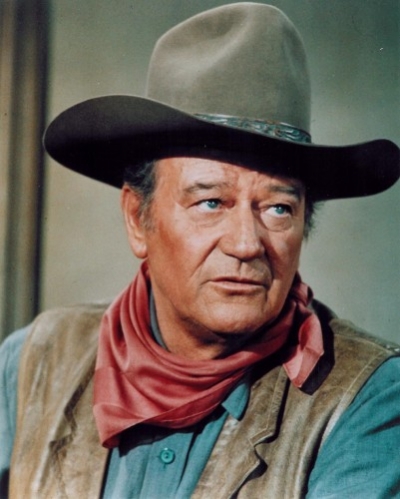
Foto: 1
Biography
This article is about the actor John Wayne. For other uses of 'John Wayne' and related names, see John Wayne (disambiguation).
U.S. John Wayne stamp from 2004
John Wayne (May 26, 1907 – June 11, 1979), popularly known as "The Duke," 1 was an American film actor whose career began in silent movies in the 1920s. He was a major star from the 1940s to the 1970s. He is most famous for his Westerns, but he also made films of various other kinds. He epitomised a certain kind of rugged individualistic masculinity, and has become an enduring icon.
Contents
1 Life and career
1.1 In memoriam John Wayne
1.2 Draft Controversy
1.3 John Wayne in modern pop culture
1.3.1 Movies and television
1.3.2 Song lyrics
2 Character deaths
3 Filmography
3.1 1920s
3.2 1930s
3.3 1940s
3.4 1950s
3.5 1960s
3.6 1970s
4 Character quotes
5 See also
6 Further reading
7 External links
8 Footnotes
Life and career
John Wayne's birthplace in Winterset, Iowa
John Wayne was born Marion Robert Morrison in Winterset, Iowa in 1907, but the name became Marion Mitchell Morrison when his parents decided to name their next son Robert; however in later life he often stated that his middle name was Michael. His family was Presbyterian; father Clyde Leonard Morrison was of Scottish descent and the son of an American Civil War veteran, while mother Mary Alberta Brown was of Irish descent. Wayne's family moved to Glendale, California in 1911; it was neighbors in Glendale who started calling him "Big Duke," because he never went anywhere without his Airedale Terrier dog, who was Little Duke. He preferred "Duke" to "Marion," and the name stuck for the rest of his life.
Duke Morrison's early life was marked by poverty; his father was a man that did not manage money well. Duke was a good student and popular. Tall from an early age, he was a star football player for Glendale High School and was recruited by the University of Southern California.
After nearly gaining admission to the U.S. Naval Academy, he attended the University of Southern California, where he was a member of the Trojan Knights and joined the Sigma Chi Fraternity. Wayne also played on the USC football team under legendary coach Howard Jones. An injury while supposedly swimming at the beach curtailed his athletic career, however; Wayne would later note that he was too terrified of Jones' reaction to reveal the actual cause of his injury. He lost his athletic scholarship and with no funds was unable to continue at USC.
While at the university, Wayne began working around the local film studios. Western star Tom Mix got him a summer job in the prop department in exchange for football tickets, and Wayne soon moved on to bit parts, establishing a long friendship with director John Ford. After two years working as a prop man at the William Fox Studios for $35 a week, his first starring role was in the 1930 movie The Big Trail; it was the director of that movie, Raoul Walsh, who gave him the stage name "John Wayne," after Revolutionary War general "Mad Anthony" Wayne. His pay was raised to $75 a week. He was tutored by the studio's stuntmen in riding and other western skills.
The Big Trail, the first 'western' epic sound motion picture, did not make Wayne a major star. Wayne would have to wait 9 more years, until his performance in the 1939 film Stagecoach achieved that. In between, he kept busy as a 'star' of the B-level westerns, most notably at Monogram Pictures as part of the trio "The Three Mesquiteers" (along with co-stars Ray Corrigan and Max Terhune).
Although he appeared in many war films and was frequently eulogized as an "American hero," unlike other prominent Hollywood actors (Clark Gable, James Stewart and Henry Fonda, to name a few), Wayne refused to fight in the Second World War, a fact that reportedly embarrassed him. His friend Bob Hope speculated that Wayne did more for the WWII war effort as an actor than he ever could on the battlefield. Between 1940, when the military draft was reinstated, and the end of World War II in 1945, he remained in Hollywood and made 21 movies. (Among them was Cecil B. DeMille's Reap the Wild Wind (1942), in which he portrayed one of the few less-than-honorable characters in his career.) He was of draft age (34) at the time of Pearl Harbor in 1941, but asked for and received a deferral for "family dependency", a classification of 3-A. This was later changed to a deferment in the "national interest", 2-A. Years later, he outspokenly criticized those who refused to fight in Vietnam.
His friendship with Ford led them to work together on films which featured some of Wayne's most iconic roles. Beginning with three minor parts in 1928, Wayne would appear in over twenty of Ford's films in the next 35 years, including Stagecoach (1939), She Wore a Yellow Ribbon (1949), The Quiet Man (1952), The Searchers (1956), The Wings of Eagles (1957) and The Man Who Shot Liberty Valance (1962).
Wayne appeared in many strong masculine roles in western films and war films, but he also had a down-to-earth sense of humor that allowed him to appear in a pink bunny suit for an episode of Rowan and Martin's Laugh-In, as well as in comedy movies. According to the Internet Movie Database Wayne played the male lead in 142 of his film appearances, an as yet unsurpassed record.
One of Wayne's most praised roles was in one of the few films he made that wasn't a Western or war picture, The High and the Mighty (1954). The movie was directed by William Wellman and based on a novel by Ernest K. Gann. Wayne played the co-pilot of a plane that develops serious engine problems in flight. His portrayal of the heroic airman won widespread acclaim. Interestingly, one of the few other non-war and non-Western films he made, Island in the Sky (1953), is also an airplane disaster movie. These two films were also made only one year apart and had the same producers, director, writer, cinematographer, editor, and distributor.
Another film which took Wayne out of the saddle was Donovan's Reef (1963), a film perhaps most memorable for its treatment of race issues. His last film with John Ford, it portrayed the Polynesians with great respect and dignity, while the white stars (except for Jack Warden's "Doctor Dedham") were comedic figures.
Despite his prolific output John Wayne won only a single Best Actor Oscar, for the 1969 movie True Grit. He received a nomination for Best Actor in Sands of Iwo Jima, and another as the producer of Best Picture nominee The Alamo, which he also directed. In 1973, he released a best-selling spoken word album titled America, Why I Love Her, that was nominated for a Grammy, and re-released with similar success in 2001. Wayne also hosted a 1970 NBC television special. "Swing Out, Sweet Land" featured cameos from some of the biggest stars of the time, from Bob Hope to Johnny Cash, giving a mostly tongue-in-cheek (yet inspiring) look at American history.
Wayne was well known for his pro-American, anti-communist conservative political views. In 1968 he directed The Green Berets, a film that overtly supported the Vietnam War. It was produced in close collaboration with the Armed Forces. It was also ironic that he appeared in an episode of the TV series Maude, created by ultra-liberal Norman Lear, and starring the liberal actress Bea Arthur, who stood 5'9" and to whom Wayne referred as "little lady". Wayne seemed to enjoy acting with actresses of a liberal bent, such as Lauren Bacall, Colleen Dewhurst, and Katharine Hepburn.
In 1970, he financed the documentary 'No Substitute for Victory'. The documentary made the claim that the US had held back from directly confronting communism in the world since the 1940s and that a "hot war" should be substituted for what was considered a sellout "cold war". The documentary further suggested that US inaction had "lost" Eastern Europe, China and North Korea to communism. Wayne in the film described an America gone soft that lacked the will to do what was necessary to win in Vietnam and against the forces of communism in general.
The High and the Mighty is one of four films (the others are Hondo, Island in the Sky, and McLintock!) that are owned outright by Batjac, a production company co-founded by Wayne and named after the fictional shipping company in The Wake of the Red Witch. Batjac now belongs to the Wayne family estate. Because of lawsuits and copyright issues with the estate, these films, with the exception of McLintock!, have not been seen for many years. Hondo was not shown from Wayne's death in 1979 until 1994, a fifteen-year hiatus. As of the end of 2005, however, Batjac has allowed The High and the Mighty and Island in the Sky to be reissued on television, and all four films released as special edition DVDs in digitally remastered versions.
John Wayne died of stomach cancer on June 11, 1979 at the age of 72 at the UCLA Medical Center. He had previously had a cancerous lung and two ribs removed in 1964. He was interred in the Pacific View Memorial Park cemetery in Corona del Mar, Orange County, California. Although he was a heavy smoker until 1964, some trace his cancer back to his work in The Conqueror, filmed about 100 miles downwind of Nevada nuclear-weapons test sites. Other actors who worked on that movie and later died of cancer include Dick Powell, Agnes Moorehead, Pedro Armendariz, Susan Hayward and John Hoyt. It should be noted however that most of these people also smoked. On June 9, 1979, the Archbishop of Panama arrived at the hospital and baptised Wayne into the Roman Catholic Church. This was at the request of his eldest son Michael, who gave him a Catholic funeral service.
Wayne was married three times, always to Spanish-speaking Latinas; to Josephine Alicia Saenz, Esperanza Baur, and Pilar Palette. He had four children with Josephine, three with Pilar, most notably actor Patrick Wayne and Ayissa Wayne who wrote a moving memoir of her life as the daughter of John Wayne. All but one of his children went on to have minor Hollywood careers.
His romance with Josie Saenz began when he was a college student and continued for 7 years before their marriage. Miss Saenz was 15 or 16 at their first meeting at a beach party at Balboa. The daughter of a successful Spanish businessman, Josie resisted considerable reluctance on the part of her family to maintain her relationship with Duke.
In the years prior to his death, Wayne was happily involved with his former secretary, Pat Stacy.
At the time of his death, John Wayne resided in a bayfront home in Newport Beach, California. His home remains a point of interest in Newport Harbor.
He is the most celebrated utterer, and apocryphal coiner, of the tmesis "ri-goddamn-diculous."
In memoriam John Wayne
There is an airport named after him, John Wayne Airport, in Orange County, California.
John Wayne was entered into the Hall of Great Western Performers of the National Cowboy and Western Heritage Museum in 1974. There is also a 100 plus mile trail, the John Wayne Pioneer Trail, in Washington States' Iron Horse State Park.
Draft Controversy
Wayne did not serve in the US military in World War II. This fact has been controversial, particularly in light of his political positions. Wayne was throughout his life an outspoken supporter of anti-communism, patriotism and the military, perhaps most well known through directing The Green Berets (1968) and his criticism of Jane Fonda. He also often was critical of those who objected to the Vietnam-era draft calling them cowards. It is true that Wayne did not serve in the military, despite being of legal draft age at the time of the Pearl Harbor attack. Wayne was 34 when the U.S. entered the war and was raising four children, and when he requested deferment he was granted a 3-A deferment for family reasons. Later in the war his deferment was changed to a 2-A deferment with the explanation that having him serve was not in the national interest. Despite not serving, Wayne did support the military through participation in USO shows for U.S. servicemen.[1]
Wayne later claimed to have applied and narrowly missed out on attending the U.S. Naval Academy, whose graduates are required to serve in the United States Navy.
John Wayne in modern pop culture
Movies and television
Characters in numerous other movies and television shows have made imitations of John Wayne. Easily imitated, with his signature swaggered walk, especially the use of the word "pilgrim," and famous lines like, "fill your hands you son-of-a-bitch," have made their way into other performances.
Jonathan Winters imitated Wayne on several occasions, and Robin Williams has even imitated Winters imitating Wayne (including in the film Good Morning Vietnam).
Clyde Kusatsu played eccentric Honolulu Detective Gordon Katsumoto on two episodes of Magnum P.I., titled "This Island Isn't Big Enough...." and "A.A.P.I." (both 1986), in which he imitated John Wayne throughout the show. The imitation went so far as to have a bronze bust of Wayne and a white cavalry hat (like the one Wayne wore in movies Rio Grande, Fort Apache, and She Wore a Yellow Ribbon,) in his office. Full Metal Jacket, the Stanley Kubrick 1987 effort has Matthew Modine doing his Wayne imitations.
1989: Holly Hunter and Brad Johnson both attempt, although poorly, to imitate "The Duke" in the movie Always.
In the 1996 film The Birdcage, Robin Williams encourages Nathan Lane to become more "manly" by walking like Wayne.
In the comic Preacher, the main character speaks to the ghost of john Wayne. During a flashback to Vietnam, John Wayne is featured speaking to the troops. Jesse has a lighter that was presented to his father (and other troops) by The Duke
Song lyrics
Wayne is mentioned in the Paula Cole song Where Have All the Cowboys Gone (lyrics) from the 1996 album "This Fire". In the song, sung from the female point of view, the singer is both: wanting a man, or men, that act like they did in the John Wayne Westerns ("Where is my John Wayne"), and at the same time making fun of, both the men of today, and the falseness of the men in the movies. In 1989, Ray Stevens released the album "Beside Myself" in which the song "Marion Michael Morrison" is dedicated to John Wayne, the lyrics containing 'Here's to you, Marion Michael Morrison. Here's to you, for all of our battles that you fought and won'.
In an uncomplimentary light in the Public Enemy (P.E.) song Fight the Power (lyrics), from the 1990 album "Fear of a Black Planet". The lyrics state that Elvis Presley was an evil racist, then seems to lump Presley and Wayne together: "Mother fuck him and John Wayne."[2] Wayne has come under fire for comments he made in a 1971 interview with Playboy, when he stated that he believed in "white supremacy" until blacks were educated enough to take a more prominent role in American society. His statement: "I believe in white supremacy until the blacks are educated to a point of responsibility. I don't believe in giving authority and positions of leadership to irresponsible people", speaks for itself.[3]
Jimmy Buffett mentions John Wayne prominently in his song Incommunicado (lyrics), on the "Coconut Telegraph" album of 1981. Jimmy is lamenting his loss and remembering such films as "Red River" and (The man who shot) "Liberty Valence".
Country duo Big & Rich mention Wayne in Save a horse, Ride a cowboy from their 2004 album Horse of a Different Color
Terry Scott Taylor, leader of the influential Christian rock band Daniel Amos, released a solo album in 1998 entitled John Wayne. The album art shows the statue of Wayne located at the John Wayne Airport. Its title track depicts Taylor musing on the foibles of modern society (including a major financial crisis of the Orange County government), and imagining Wayne responding to Taylor's appeals for assistance from "the Duke" in 'cleaning up' the problems.
Character deaths
Spoiler warning: Plot and/or ending details follow.
A frequently asked trivia question is: In how many films did John Wayne's character die? The answer is as follows:
His death is seen in the following films:
The Shootist - After winning a seemingly hopeless gunfight with three opponents simultaneously, he is shot by the bartender, and is then avenged by Ron Howard's character.
The Cowboys - He is killed by Bruce Dern's character.
The Alamo - Playing Davy Crockett, he is killed by a Mexican soldier's lance.
Sands of Iwo Jima - He is killed by a bullet fired by a Japanese soldier who is hiding under concealment at the end of the film.
Wake of the Red Witch - He dies as the ship sinks.
The Fighting Seabees - He is shot by a sniper.
Reap the Wild Wind - He is trapped inside the wreck of a sunken ship after a fight with a giant squid and drowns.
His character death is not shown in the following:
The Man Who Shot Liberty Valance - His character is dead at the beginning of the film and the story is told in flashback by James Stewart who is attending his funeral.
The Sea Chase - Lana Turner and Wayne are on a ship when it sinks, but the possibility that the characters survived is left open.
The Deceiver - Ian Keith's character died, but the corpse was played by John Wayne.
Central Airport - John Wayne has a very minor role as the co-pilot of an aircraft that crashes into the ocean.
Filmography
1920s
Brown of Harvard (1926)
Bardelys the Magnificent (1926)
The Great K & A Train Robbery (1926)
Annie Laurie (1927)
The Drop Kick (1927)
Mother Machree (1928)
Four Sons (1928)
Hangman's House (1928)
Speakeasy (1929)
The Black Watch (1929)
Noah's Ark (1929)
Words and Music (1929)
Salute (1929)
The Forward Pass (1929)
1930s
Men Without Women (1930)
Born Reckless (1930)
Rough Romance (1930)
Cheer Up and Smile (1930)
The Big Trail (1930)
Girls Demand Excitement (1931)
Three Girls Lost (1931)
Arizona (1931)
The Deceiver (1931)
Range Feud (1931)
Maker of Men (1931)
The Voice of Hollywood No. 13 (1932) (short subject)
Running Hollywood (1932) (short subject)
The Shadow of the Eagle (1932)
Texas Cyclone (1932)
Two-Fisted Law (1932)
Lady and Gent (1932)
The Hurricane Express (1932)
The Hollywood Handicap (1932) (short subject)
Ride Him, Cowboy (1932)
That's My Boy (1932)
The Big Stampede (1932)
Haunted Gold (1932)
The Telegraph Trail (1933)
The Three Musketeers (1933)
Central Airport (1933)
Somewhere in Sonora (1933)
His Private Secretary (1933)
The Life of Jimmy Dolan (1933)
Baby Face (1933)
The Man From Monterey (1933)
Riders of Destiny (1933)
College Coach (1933)
Sagebrush Trail (1933)
The Lucky Texan (1934)
West of the Divide (1934)
Blue Steel (1934)
The Lawless Frontier (1934)
Helltown (1934)
The Man from Utah (1934)
Randy Rides Alone (1934)
The Star Packer (1934)
The Trail Beyond (1934)
The Lawless Beyond (1934)
'Neath the Arizona Skies (1934)
Texas Terror (1935)
Rainbow Valley (1935)
The Desert Trail (1935)
The Dawn Rider (1935)
Paradise Canyon (1935)
Westward Ho (1935)
The New Frontier (1935)
Lawless Range (1935)
The Oregon Trail (1936)
The Lawless Nineties (1936)
King of the Pecos (1936)
The Lonely Trail (1936)
Winds of the Wasteland (1936)
Sea Spoilers (1936)
Conflict (1936)
California Straight Ahead! (1937)
I Cover the War (1937)
Idol of the Crowds (1937)
Adventure's End (1937)
Born to the West (1937)
Pals of the Saddle (1938)
Overland Stage Raiders (1938)
Santa Fe Stampede (1938)
Red River Range (1938)
Stagecoach (1939)
The Night Riders (1939)
Three Texas Steers (1939)
Wyoming Outlaw (1939)
New Frontier (1939)
Allegheny Uprising (1939)
1940s
Meet the Stars: Cowboy Jubilee (1940) (short subject)
Three Faces West (1940)
The Long Voyage Home (1940)
Seven Sinners (1940)
A Man Betrayed (1941)
Lady from Louisiana (1941)
The Shepherd of the Hills (1941)
Meet the Stars: Past and Present (1941) (short subject)
Lady for a Night (1942)
Reap the Wild Wind (1942)
The Spoilers (1942)
In Old California (1942)
Flying Tigers (1942)
Pittsburgh (1942)
Reunion in France (1942)
A Lady Takes a Chance (1943)
In Old Oklahoma (1943)
The Fighting Seabees (1944)
Tall in the Saddle (1944)
Flame of Barbary Coast (1945)
Back to Bataan (1945)
They Were Expendable (1945)
Dakota (1945)
Without Reservations (1946)
Angel and the Badman (1947) (also producer)
Tycoon (1947)
Red River (1948)
Fort Apache (1948)
3 Godfathers (1948)
Wake of the Red Witch (1948)
The Fighting Kentuckian (1949) (also producer)
She Wore a Yellow Ribbon (1949)
Screen Snapshots: Hollywood Rodeo (1949) (short subject)
Sands of Iwo Jima (1949)
1950s
Rio Grande (1950)
Screen Snapshots: Reno's Silver Spur Awards (1951) (short subjects)
Operation Pacific (1951)
The Screen Director (1951) (short subject)
Screen Snapshots: Hollywood Awards (1951) (short subject)
Flying Leathernecks (1951)
Miracle in Motion (1952) (short subject) (narrator)
The Quiet Man (1952)
Big Jim McLain (1952) (also producer)
Trouble Along the Way (1953)
Island in the Sky (1953) (also producer)
Hondo (1953) (also producer)
The High and the Mighty (1954) (also producer)
The Sea Chase (1955)
Screen Snapshots: The Great Al Jolson (1955) (short subject)
Blood Alley (1955) (also director and producer)
The Conqueror (1956)
The Searchers (1956)
The Wings of Eagles (1957)
Jet Pilot (1957)
Legend of the Lost (1957)
I Married a Woman (1958) (Cameo)
The Barbarian and the Geisha (1958)
Rio Bravo (1959)
The Horse Soldiers (1959)
1960s
The Alamo (1960) (also director and producer)
North to Alaska (1960)
The Challenge of Ideas (1961) (short subject) (narrator)
The Comancheros (1961) (also director)
The Man Who Shot Liberty Valance (1962)
Hatari! (1962)
The Longest Day (1962)
How the West Was Won (1962)
McLintock! (1963)
Donovan's Reef (1963)
Circus World (1964)
The Greatest Story Ever Told (1965)
In Harm's Way (1965)
The Sons of Katie Elder (1965)
Cast a Giant Shadow (1966)
El Dorado (1966)
A Nation Builds Under Fire (1967) (short subject) (narrator)
The War Wagon (1967)
The Green Berets (1968) (also director)
Hellfighters (1968)
True Grit (1969)
The Undefeated (1969)
1970s
No Substitute for Victory (1970) (documentary)
Chisum (1970)
Rio Lobo (1970)
Big Jake (1971) (also co-director)
Directed by John Ford (1971) (documentary)
The Cowboys (1972)
Cancel My Reservation (1972) (Cameo)
The Train Robbers (1973)
Cahill U.S. Marshall (1973)
McQ (1974)
Brannigan (1975)
Rooster Cogburn (1975)
Chesty: Tribute to a Legend (1976) (documentary) (narrator)
The Shootist (1976)
Character quotes
Wikiquote has a collection of quotations related to:
"Tomorrow is the most important thing in life. Comes into us at midnight very clean. It's perfect when it arrives and it puts itself in our hands. It hopes we've learned something from yesterday."
"I won't be wronged, I won't be insulted, and I won't be laid a hand on. I don't do these things to other people and I expect the same from them." (From The Shootist)
"Courage is being scared to death - but saddling up anyway."
See also
Other notable figures in Western films
List of film collaborations
Further reading
Campbell, James T. "Print the Legend: John Wayne and Postwar American Culture" in: Reviews in American History - Volume 28, Number 3, September 2000, pp. 465-477
Shepherd, Donald, and Robert Slatzer, with Dave Grayson. Duke: The Life and Times of John Wayne. New York: Doubleday, 1985. ISBN 038517893X
Carey, Harry Jr., "A Company of Heroes: My Life as an Actor in the John Ford Stock Company". Lanham, Maryland: Scarecrow Press, 1994. ISBN 0810828650
Clark, Donald & Christopher Anderson, "John Wayne's The Alamo: The Making of the Epic Film". New York: Carol Publishing Group, 1995. ISBN 0-8065-1625-9 (pbk.)
Eyman, Scott, "Print the Legend: The Life and Times of John Ford". New York: Simon & Schuster, 1999. ISBN 0-684-81161-8
McCarthy, Todd, "Howard Hawks: The Grey Fox of Hollywood". New York: Grove Press, 1997. ISBN 0-8021-1598-5
Zolotow, Maurice, "Shooting Star: A Biography of John Wayne". New York: Simon & Schuster, 1974. ISBN 671-80211-9



